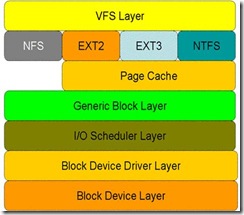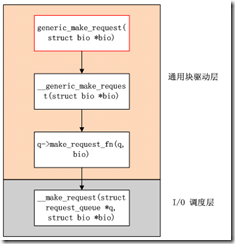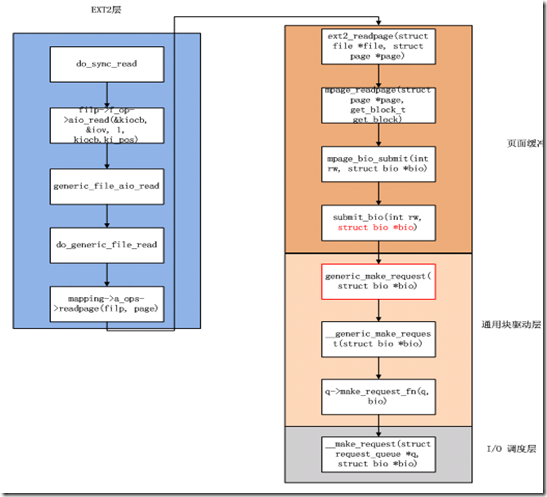注:
本片文章以Read函数的调用为例来讲述一下系统对块驱动层的一些处理, 哈哈。如果有不正确或者不完善的地方,欢迎前来拍砖留言或者发邮件到guopeixin@126.com进行讨论,先行谢过。
一.Read函数经由的层次模型
首先来了解一下Read函数经由的层次模型:

从图中可以看出,对于磁盘的一次读请求,首先经过虚拟文件系统层(vfs layer),其次是具体的文件系统层(例如 ext2),接下来是 cache 层(page cache 层)、通用块层(generic block layer)、IO 调度层(I/O scheduler layer)、块设备驱动层(block device driver layer),最后是物理块设备层(block device layer)。
下面摘抄一份文档,来对上面的各个层面的作用做一些简述:
• 虚拟文件系统层的作用:屏蔽下层具体文件系统操作的差异,为上层的操作提供一个统一的接口。正是因为有了这个层次,所以可以把设备抽象成文件,使得操作设备就像操作文件一样简单。
• 在具体的文件系统层中,不同的文件系统(例如 ext2 和 NTFS)具体的操作过程也是不同的。每种文件系统定义了自己的操作集合。关于文件系统的更多内容,请参见参考资料。
• 引入 cache 层的目的是为了提高 linux 操作系统对磁盘访问的性能。 Cache 层在内存中缓存了磁盘上的部分数据。当数据的请求到达时,如果在 cache 中存在该数据且是最新的,则直接将数据传递给用户程序,免除了对底层磁盘的操作,提高了性能。
• 通用块层的主要工作是:接收上层发出的磁盘请求,并最终发出 IO 请求。该层隐藏了底层硬件块设备的特性,为块设备提供了一个通用的抽象视图。
• IO 调度层的功能:接收通用块层发出的 IO 请求,缓存请求并试图合并相邻的请求(如果这两个请求的数据在磁盘上是相邻的)。并根据设置好的调度算法,回调驱动层提供的请求处理函数,以处理具体的 IO 请求。
• 驱动层中的驱动程序对应具体的物理块设备。它从上层中取出 IO 请求,并根据该 IO 请求中指定的信息,通过向具体块设备的设备控制器发送命令的方式,来操纵设备传输数据。
• 设备层中都是具体的物理设备。定义了操作具体设备的规范。
二.系统调用的发起点sys_read
1. sys_read代码分析
Sys_read最终被注册为系统API,在很多的系统模块中都可以看到该API的调用。
函数sys_read()的代码如下:
| asmlinkage ssize_t sys_read(unsigned int fd, char __user * buf, size_t count) { struct file *file; ssize_t ret = -EBADF; int fput_needed; file = fget_light(fd, &fput_needed); if (file) { loff_t pos = file_pos_read(file); ret = vfs_read(file, buf, count, &pos); file_pos_write(file, pos); fput_light(file, fput_needed); } return ret; } ssize_t vfs_read(struct file *file, char __user *buf, size_t count, loff_t *pos) { ssize_t ret; if (!(file->f_mode & FMODE_READ)) return -EBADF; if (!file->f_op || (!file->f_op->read && !file->f_op->aio_read)) return -EINVAL; if (unlikely(!access_ok(VERIFY_WRITE, buf, count))) return -EFAULT; ret = rw_verify_area(READ, file, pos, count); if (ret >= 0) { count = ret; if (file->f_op->read) ret = file->f_op->read(file, buf, count, pos); else ret = do_sync_read(file, buf, count, pos); if (ret > 0) { fsnotify_access(file->f_path.dentry); add_rchar(current, ret); } inc_syscr(current); } return ret; } |
从上面可以看到,调用Stack为sys_read()àvfs_read()àfile->f_op->read()。而file->f_op->read实际上就是具体的文件系统向通用Block层注册的一个函数指针,对于本文中讲述的EXT2文件系统来说,实际上就是do_sync_read。
三.Ext2文件系统在sys_read调用过程中的角色
1. Ext2文件系统file_operations接口的注册过程
Ext2文件系统的模块初始化函数会去注册操作接口ext2_file_operations,调用Stack如下init_ext2_fs()à register_filesystem()àext2_get_sb()àext2_fill_super()àext2_iget(),其中函数ext2_iget()会获取结构体file_operations的值。其中,接口的定义如下:
| /* * We have mostly NULL's here: the current defaults are ok for * the ext2 filesystem. */ const struct file_operations ext2_file_operations = { .llseek = generic_file_llseek, .read = do_sync_read, .write = do_sync_write, .aio_read = generic_file_aio_read, .aio_write = generic_file_aio_write, .unlocked_ioctl = ext2_ioctl, #ifdef CONFIG_COMPAT .compat_ioctl = ext2_compat_ioctl, #endif .mmap = generic_file_mmap, .open = generic_file_open, .release = ext2_release_file, .fsync = ext2_sync_file, .splice_read = generic_file_splice_read, .splice_write = generic_file_splice_write, };
const struct address_space_operations ext2_aops = { .readpage = ext2_readpage, .readpages = ext2_readpages, .writepage = ext2_writepage, .sync_page = block_sync_page, .write_begin = ext2_write_begin, .write_end = generic_write_end, .bmap = ext2_bmap, .direct_IO = ext2_direct_IO, .writepages = ext2_writepages, .migratepage = buffer_migrate_page, .is_partially_uptodate = block_is_partially_uptodate, }; const struct address_space_operations ext2_nobh_aops = { .readpage = ext2_readpage, .readpages = ext2_readpages, .writepage = ext2_nobh_writepage, .sync_page = block_sync_page, .write_begin = ext2_nobh_write_begin, .write_end = nobh_write_end, .bmap = ext2_bmap, .direct_IO = ext2_direct_IO, .writepages = ext2_writepages, .migratepage = buffer_migrate_page, }; |
而函数ext2_iget()中的相关代码如下:
| struct inode *ext2_iget (struct super_block *sb, unsigned long ino) { ... if (S_ISREG(inode->i_mode)) { inode->i_op = &ext2_file_inode_operations; if (ext2_use_xip(inode->i_sb)) { inode->i_mapping->a_ops = &ext2_aops_xip; inode->i_fop = &ext2_xip_file_operations; } else if (test_opt(inode->i_sb, NOBH)) { inode->i_mapping->a_ops = &ext2_nobh_aops; inode->i_fop = &ext2_file_operations; } else { inode->i_mapping->a_ops = &ext2_aops; inode->i_fop = &ext2_file_operations; } } else if (S_ISDIR(inode->i_mode)) { inode->i_op = &ext2_dir_inode_operations; inode->i_fop = &ext2_dir_operations; if (test_opt(inode->i_sb, NOBH)) inode->i_mapping->a_ops = &ext2_nobh_aops; else inode->i_mapping->a_ops = &ext2_aops; } else if (S_ISLNK(inode->i_mode)) { if (ext2_inode_is_fast_symlink(inode)) inode->i_op = &ext2_fast_symlink_inode_operations; else { inode->i_op = &ext2_symlink_inode_operations; if (test_opt(inode->i_sb, NOBH)) inode->i_mapping->a_ops = &ext2_nobh_aops; else inode->i_mapping->a_ops = &ext2_aops; } } else { inode->i_op = &ext2_special_inode_operations; if (raw_inode->i_block[0]) init_special_inode(inode, inode->i_mode, old_decode_dev(le32_to_cpu(raw_inode->i_block[0]))); else init_special_inode(inode, inode->i_mode, new_decode_dev(le32_to_cpu(raw_inode->i_block[1]))); } ... } |
2. 系统Read过程调用在该层的Stack

四.Page Cache在Sys_read调用过程中所做的工作
1. Page Cache在Sys_read调用过程中所做的工作
从前面粘贴的函数ext2_iget()的代码中中可以看到inode->i_mapping->a_ops = &ext2_aops,实际上这里就是注册了页面缓存的一些接口。
上一部分提到Ext2调用的结束点就是mappingàa_opsàreadpage(file, page),实际上执行的就是ext2_aops.readpage(file, page),也即ext2_readpage。
有关函数ext2_readpage()的调用Stack如下:

五.通用Block层和IO Schedule层扮演的角色
这部分相对比较简单,通过函数submit_bio()的调用直接可以找到,相关调用Stack如下:

六.Driver所做的事情
哎呀,分析了半天还没有看到块设备驱动的参与,不要急,这里就来了,呵呵。
在块设备驱动中一般会调用通过Block层的导出函数blk_init_queue()来注册执行具体操作的函数,形如q->request_fn = rfn。
相关代码如下:
| struct request_queue * blk_init_queue_node(request_fn_proc *rfn, spinlock_t *lock, int node_id) { struct request_queue *q = blk_alloc_queue_node(GFP_KERNEL, node_id); if (!q) return NULL; q->node = node_id; if (blk_init_free_list(q)) { kmem_cache_free(blk_requestq_cachep, q); return NULL; } /* * if caller didn't supply a lock, they get per-queue locking with * our embedded lock */ if (!lock) lock = &q->__queue_lock; q->request_fn = rfn; q->prep_rq_fn = NULL; q->unplug_fn = generic_unplug_device; q->queue_flags = (1 << QUEUE_FLAG_CLUSTER); q->queue_lock = lock; blk_queue_segment_boundary(q, 0xffffffff); blk_queue_make_request(q, __make_request); blk_queue_max_segment_size(q, MAX_SEGMENT_SIZE); blk_queue_max_hw_segments(q, MAX_HW_SEGMENTS); blk_queue_max_phys_segments(q, MAX_PHYS_SEGMENTS); q->sg_reserved_size = INT_MAX; blk_set_cmd_filter_defaults(&q->cmd_filter); /* * all done */ if (!elevator_init(q, NULL)) { blk_queue_congestion_threshold(q); return q; } blk_put_queue(q); return NULL; } |
至此,整个流程分析完毕。
最终,汇总的流程图如下:

注:
根据吴仲杰大哥描述,函数request_fn确实是块驱动的入口。




)







)

)




